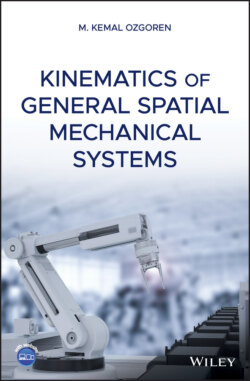Читать книгу Kinematics of General Spatial Mechanical Systems - M. Kemal Ozgoren - Страница 50
3.2.2 Basic Properties of a Transformation Matrix
Оглавление1 (a) Inversion Property
Equation (3.11) can also be written in the following two ways: first by inverting ; and then by interchanging the frame indicators a and b.
(3.12)
(3.13)
Equations (3.11)–(3.13) imply the following equalities.
(3.14)
(3.15)
1 (b) Orthonormality Property
As also mentioned in Chapter 1, all the reference frames considered in this book are assumed to be orthonormal, right‐handed, and equally scaled on their axes. Therefore, the magnitude of a vector appears to be the same in every reference frame. This fact is expressed as follows:
(3.16)
After substituting Eq. (3.11), Eq. (3.16) can be manipulated as shown below.
(3.17)
Equation (3.17) implies the following successive equations.
(3.18)
(3.19)
Furthermore, when Eqs. (3.19) and (3.14) are compared, it is seen that
(3.20)
As seen above, the inverse of a transformation matrix is equal to its transpose. This property makes a transformation matrix an element of the set of orthonormal matrices just like a rotation matrix. The orthonormality of a rotation matrix was shown in Chapter 2.
1 (c) Combination Property
If a vector is observed in three differently oriented reference frames, such as , , and , the following equations can be written to relate its column matrix representations.
(3.21)
(3.22)
(3.23)
On the other hand, the combination of Eqs. (3.21) and (3.22) results in
(3.24)
Equations (3.23) and (3.24) imply that
(3.25)
Equation (3.25) can be extended to more than three reference frames as follows:
(3.26)
